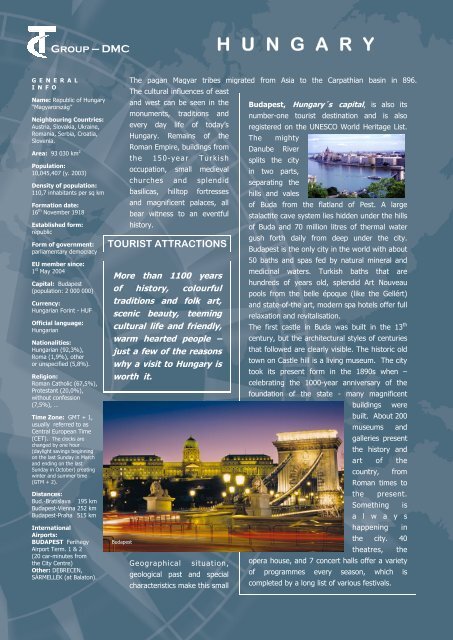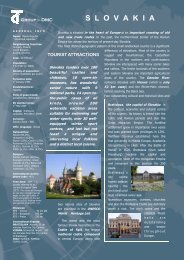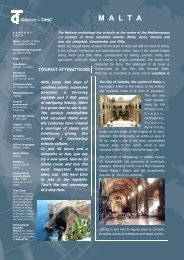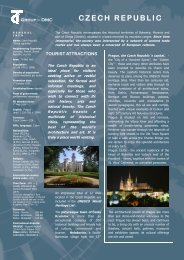H U N G A R Y
Sie wollen auch ein ePaper? Erhöhen Sie die Reichweite Ihrer Titel.
YUMPU macht aus Druck-PDFs automatisch weboptimierte ePaper, die Google liebt.
Group — DMC<br />
H U N G A R Y<br />
G E N E R A L<br />
I N F O<br />
Name: Republic of Hungary<br />
“Magyarország”<br />
Neighbouring Countries:<br />
Austria, Slovakia, Ukraine,<br />
Romania, Serbia, Croatia,<br />
Slovenia.<br />
Area: 93 030 km 2<br />
Population:<br />
10,045,407 (y. 2003)<br />
Density of population:<br />
110,7 inhabitants per sq km<br />
Formation date:<br />
16 th November 1918<br />
Established form:<br />
republic<br />
Form of government:<br />
parliamentary democracy<br />
EU member since:<br />
1 st May 2004<br />
Capital: Budapest<br />
(population: 2 000 000)<br />
Currency:<br />
Hungarian Forint - HUF<br />
Official language:<br />
Hungarian<br />
Nationalities:<br />
Hungarian (92,3%),<br />
Roma (1,9%), other<br />
or unspecified (5,8%).<br />
Religion:<br />
Roman Catholic (67,5%),<br />
Protestant (20,0%),<br />
without confession<br />
(7,5%), …<br />
Time Zone: GMT + 1,<br />
usually referred to as<br />
Central European Time<br />
(CET). The clocks are<br />
changed by one hour<br />
(daylight savings beginning<br />
on the last Sunday in March<br />
and ending on the last<br />
Sunday in October) creating<br />
winter and summer time<br />
(GTM + 2).<br />
Distances:<br />
Bud.-Bratislava 195 km<br />
Budapest-Vienna 252 km<br />
Budapest-Praha 515 km<br />
International<br />
Airports:<br />
BUDAPEST Ferihegy<br />
Airport Term. 1 & 2<br />
(20 car-minutes from<br />
the City Centre)<br />
Other: DEBRECEN,<br />
SÁRMELLÉK (at Balaton).<br />
The pagan Magyar tribes migrated from Asia to the Carpathian basin in 896.<br />
The cultural influences of east<br />
and west can be seen in the<br />
monuments, traditions and<br />
every day life of today’s<br />
Hungary. Remains of the<br />
Roman Empire, buildings from<br />
the 15 0-year T urkish<br />
occupation, small medieval<br />
churches and splendid<br />
basilicas, hilltop fortresses<br />
and magnificent palaces, all<br />
bear witness to an eventful<br />
history.<br />
TOURIST ATTRACTIONS<br />
More than 1100 years<br />
of history, colourful<br />
traditions and folk art,<br />
scenic beauty, teeming<br />
cultural life and friendly,<br />
warm hearted people –<br />
just a few of the reasons<br />
why a visit to Hungary is<br />
worth it.<br />
Budapest<br />
Geographical<br />
situation,<br />
geological past and special<br />
characteristics make this small<br />
Budapest, Hungary´s capital, is also its<br />
number-one tourist destination and is also<br />
registered on the UNESCO World Heritage List.<br />
The<br />
Danube<br />
mighty<br />
River<br />
splits the city<br />
in two parts,<br />
separating the<br />
hills and vales<br />
of Buda from the flatland of Pest. A large<br />
stalactite cave system lies hidden under the hills<br />
of Buda and 70 million litres of thermal water<br />
gush forth daily from deep under the city.<br />
Budapest is the only city in the world with about<br />
50 baths and spas fed by natural mineral and<br />
medicinal waters. Turkish baths that are<br />
hundreds of years old, splendid Art Nouveau<br />
pools from the belle époque (like the Gellért)<br />
and state-of-the art, modern spa hotels offer full<br />
relaxation and revitalisation.<br />
The first castle in Buda was built in the 13 th<br />
century, but the architectural styles of centuries<br />
that followed are clearly visible. The historic old<br />
town on Castle hill is a living museum. The city<br />
took its present form in the 1890s when –<br />
celebrating the 1000-year anniversary of the<br />
foundation of the state - many magnificent<br />
buildings<br />
were<br />
built. About 200<br />
museums<br />
and<br />
galleries present<br />
the history and<br />
art of the<br />
country,<br />
from<br />
Roman times to<br />
the<br />
Something<br />
present.<br />
is<br />
a l w a y s<br />
happening<br />
in<br />
the city. 40<br />
theatres,<br />
the<br />
opera house, and 7 concert halls offer a variety<br />
of programmes every season, which is<br />
completed by a long list of various festivals.
Group — DMC<br />
H U N G A R Y<br />
PAGE 2<br />
country unbelievably rich in natural resources. The 10 national parks include wild river areas, forest-covered<br />
mountain ridges, inactive volcanic areas, endless plains and fairy-tale stalactite caves.<br />
Among its treasures of culture and nature, Hungary is proud to boast 8 UNESCO World Heritage sites including<br />
Budapest. City of Pécs - founded by the Romans at the beginning of the 2 nd cent. AD - has a real Mediterranean<br />
atmosphere, due to its climate, flora and narrow, rambling streets. The collection of buildings of the early<br />
Christian cemetery of ancient Sopianae, with biblical frescoes decorating the walls of the tombs, the chapel<br />
and the mausoleum, is regarded as an unrivalled group of cultural monuments.<br />
The small village of Hollókő represents a preserved traditional medieval<br />
village structure.<br />
The history of the Benedictine Monastery of Pannonhalma is as old as that<br />
of Hungary. Géza, leader of the pagan Magyar tribes, and his son King (later Saint)<br />
Stephen recognised that the Hungarian people could only survive if they created a<br />
solid, feudal state and adopted Christianity. Géza invited Italian and Czech<br />
Benedictine monks into the country. Their first monastery was built in Pannonhalma,<br />
and is not only exceptional with regard to its role in Hungarian history, but it also<br />
acquires great importance, together with its harmonious natural environment, as a<br />
piece of architecture, a work of art.<br />
Basilica in Pannonhalma<br />
The natural beauty and Lake Fertő is situated on the territory of Austria and<br />
Hungary. It is the westernmost example of the Eurasian steppe lakes and at the<br />
same time is Europe’s largest salt-water lake. The settlements around the lake date back to the Middle Ages.<br />
Hortobágy, a National Park, is the largest continuous natural grassland in Europe. So far, the<br />
appearance of 342 bird species has been reported here. The most exciting sight is the autumn migration when –<br />
among other birds – tens of thousands of cranes fly over the spectator’s head.<br />
Another entry, the more than 700 caves of the Aggtelek and Slovak Karst form the largest cave system of<br />
Central Europe.<br />
The name of Tokaj is identified with wine all over the world. The exceptional microclimate of the region stretching<br />
also to Slovakia, the soil conditions created as a result of volcanic & post-volcanic activities, the favourably<br />
situated slopes, the autumn mist caused by the rivers Tisza & Bodrog, the fermentation in oak barrels and the<br />
special mould on the cellar walls - these all contribute to producing “the king of wines and the wine of kings”.<br />
Central Europe’s largest Jewish community lives in Hungary, mainly in Budapest. Jewish traditions, architecture<br />
and art form a valuable part of Hungarian culture. As early as in the 3 rd century AD the Jews were living in the<br />
Roman province of Pannonia - Transdanubia in today’s Hungary. From the time of the Hungarian Conquest, written<br />
documents prove the existence of Jewish communities in Hungary, so the history of Hungarian Jewry and that of<br />
Hungary itself are almost inseparable. By the middle of the 17 th century the Jewish community in Buda had become<br />
one of the largest congregations in Europe. Today there are 48 synagogues in Hungary, almost half of them in<br />
Budapest, including Europe’s largest active synagogue on Dohány street.<br />
Budapest, Spa Gellert<br />
The abundance of thermal and medicinal (thermo-mineral healing) springs<br />
is amazing - wherever a hole is drilled in a quest for oil, healing waters are<br />
found in the deep. The local culture of bathing goes back 2000 years; excavated<br />
remains of bath houses, frescoes and mosaics demonstrate that the Romans<br />
discovered and exploited these thermal water resources. Of the approximately<br />
1300 thermal springs currently registered, nearly 300 are used for bathing purposes.<br />
The habit of bathing and relaxing in the warm waters is a part of everyday<br />
life, just like the rich flavours of Hungary´s traditional food and wines from the country´s 22 wine regions.






